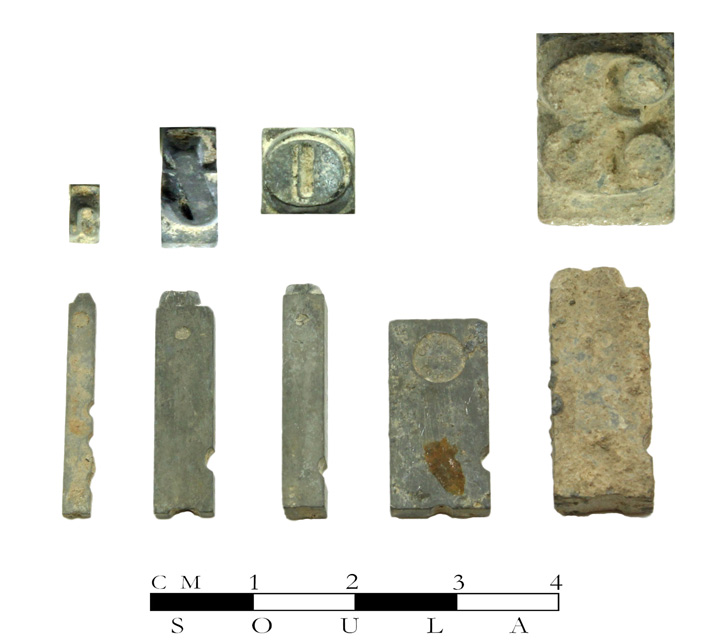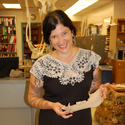Digging Jacksonville – April 2016
Archeological excavations in Jacksonville’s Chinese Quarter regularly turn up examples of printer’s type, the latest dig finding five examples. The archaeologist naturally wants to know when the artifacts found their way to the neighborhood, but more importantly, what is type doing in the Chinese Quarter, blocks from the nearest print shop?
The most recent dig found a 12-point capital “O” of an unidentified inline font, a 16-point lower case bold or medium italic “t” similar to the Century font, and a 24-point thin space (a “blank,” used as a word space), along with a lower case “a,” and the number “3.” Assigning a date to a font based on a single letter is fraught with assumptions and suppositions—something best avoided in the sciences, but that doesn’t mean that there’s nothing to be said about these artifacts’ provenance.
The lowercase “t” belongs to the roman family of letterforms, in use since the beginning of printing in the 15th century, and is not easily dateable without a larger sample. The capital “O,” however, is distinctive enough to be able to identify which font it is and vaguely when it was in use, should you find it used in a printed piece at the Southern Oregon Historical Society. Unfortunately for a search like this, SOHS’ examples of early Jacksonville printing are spread throughout their collection; it would require hundreds of hours to find them and examine their “O’s.”
Early Jacksonville newspapers are quite a bit more accessible, but offer few examples of “fancy” type in their advertising sections. A few hours of going through old newspapers finds similar fonts in the Democratic Times of 1872 and the Oregon Intelligencer of 1864, but no matches. The search does reveal that, at least locally, there seems to have been a trend away from fancy types all through the 1880s—at least in newspaper usage. This could be misleading: the “O” font may never have been used in a local newspaper while seeing a lot of service in the calling cards, billheads or handbills that were the mainstay of the job shops operated by the newspapers. Without looking at every piece of paper at SOHS there’s really no way to tell.
How did the type find its way to the Chinese Quarter? The type could have become separated from the printing plants after the fire that destroyed the Democratic Times in 1871 or ’72, or during the dissolution of one of Jacksonville’s short-lived newspapers, like the Herald in 1858, the Gazette in 1861, or the Intelligencer in 1863. Or they could have just been swept out the back door one at a time and picked up by a thrifty resident—or a curious child.
The regularity with which the type is excavated does suggest an adult’s persistence to amass enough type for a practical purpose. The preponderance of lead in the type metal alloy gives it a useful heft and a low melting point—any number of useful objects could be created with a pot on a stovetop and a homemade mold, including the immediately obvious bullets and fishing weights. I still have a spindle I made in my printing days, using nothing more than a bit of sharpened coat hanger wire and a cardboard mold.
Medford resident Ben Truwe is a recovering printer and a trustee of the Southern Oregon Historical Society. He is the author of the Looking Back Jackson County history books and the Southern Oregon History, Revised website. He is currently occupied transferring SOHS’ 16mm film collection to video and transcribing the correspondence of the Oregon Superintendency of Indian Affairs. You can reach SOULA by contacting Chelsea Rose at rosec@sou.edu and follow SOULA on facebook/Southern Oregon University Laboratory of Anthropology.


 Chelsea Rose is an historical archaeologist who specializes in the settlement and development of the American West. Chelsea and the Southern Oregon University Laboratory of Anthropology (SOULA) conduct archaeology across Oregon and have done several projects in Jacksonville. You can reach Chelsea at rosec@sou.edu and follow SOULA on
Chelsea Rose is an historical archaeologist who specializes in the settlement and development of the American West. Chelsea and the Southern Oregon University Laboratory of Anthropology (SOULA) conduct archaeology across Oregon and have done several projects in Jacksonville. You can reach Chelsea at rosec@sou.edu and follow SOULA on